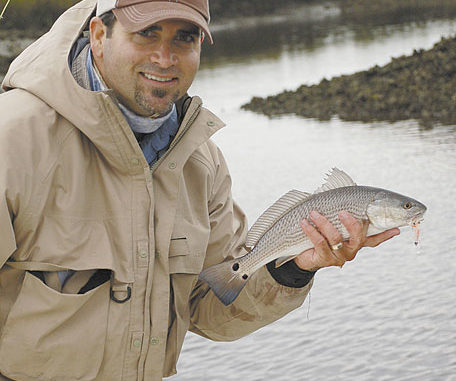
Clear water and schooling, winter redfish in the Little River area are the perfect match for anglers who love to fly-fish.
The chilly breezes and frigid waters of winter often fail to deter fishermen targeting redfish that prowl the pristine, remote mud flats around the North Carolina-South Carolina border. February is frequently recognized as a prime month to target reds, which congregate in tight schools on the flats. Whether you’re looking at mud plumes, wakes or the fish themselves, wintertime fishing for reds (aka puppy drum, spot-tail bass) is almost completely based on sight.
In fact, reds are at home in 16 inches of water as the mercury cascades to below-normal temperatures. A delicate approach and presentation is a key to success on the crystal-clear waters, making way for the perfect offering, the fly.
Fly-fishing techniques provide a way to make a gentle offering to spooky reds, weary from the year-round attention of anglers. Fly casters can present natural imitations to visible targets without disturbing the water with the heavier artificial lures associated with spinning or baitcasting tackle. And with bait being fairly scarce, gently sweeping a Clouser minnow into a pod of fish quickly narrows the gap between the fish and angler. Novice and advanced fly-casters can be rewarded with some memorable, rod-bending action.
Patrick Kelly, aka Capt. Smiley, has seen plenty of flies inhaled by reds. A full-time guide who operates Captain Smiley Fishing Charters out of Little River, S.C., he’s well set-up to the optimal weather conditions that allow him to take fly-fishermen on his 17-foot Key West flats boat, which can operate in extremely skinny water.
Jan Peele, the fly-fishing manager and an instructor at the Orvis retail store in Myrtle Beach, S.C., was just that person on a recent outing. The trip started off, like many others, with plenty of cold-weather gear and an anxious fisherman with a box full of hand-tied Clousers and shrimp imitations of various colors, shapes and sizes and a 9-foot, 7-weight Helios rod.
“Ideally, you want to fish on slightly warmer days with a mid-day low tide,” said Kelly (843-361-7445). “The full sun on low water warms the mud and the rising waters quickly. Once the water starts moving back into the creeks, we can slip further into the remote shallows to several places habitually used by reds in winter.”
With Peele in tow, Kelly eased into the ICW near Sunset Beach, then into narrow water courses, weaving back and forth along twists and turns, taking care to avoid exposed oyster and mud bars scattered along the way. Shutting down the outboard and taking up poling from a raised platform, he began pushing his skiff up the creek, scanning for water disturbances and mud plumes, tell-tale signs of loitering redfish. With few other species around during the winter, any disturbance not caused from above is generally caused by a redfish.
After navigating several creek bends, Kelly said, in an exited voice, “I see them. They are pushing right next to the light-colored oyster shells around the next curve. Get ready Jan!”
Kelly positioned the boat to give Peele the best angle for his upcoming cast. As they approached, the loafing redfish were revealed to be completely unaware of danger, and Peele began to wind up, stripping several feet of brightly colored fly line into a basket, then making a handful of false casts until landing his offering perfectly, just in front of the target.
After several slow strips, Peele suddenly snatched the rod back and buried the sharp end of an olive/tan, bend-back Clouser into place. The water erupted, and the rod doubled over.
“There he is!” Peele shouted as he began battling an 18-inch redfish in the shallow waters. The fish took little interest in joining Kelly’s posse, but it caved in after several minutes of fruitless struggle.
“They’re just where they are supposed to be, Jan, and he should have several pals hanging by the same creek opening,” Kelly said.
Oyster bars, and mud flats are abundant in coastal estuaries, but redfish will only certain places home during the winter. They will use familiar areas throughout the year, but wintertime spots are more predictable. Even though the majority of the extreme backwaters are super shallow, any spot with a relatively deep channel nestled adjacent to a shallow flats is idea.
Kelly prefers protected areas deep in marshes abundant with firm mud flats and oyster points sloughing into 2- to 3-foot holes or channels. Redfish will congregate during the winter, often forming schools as large as 300 to 400 fish.
In certain cases, holes with four to six feet of water will be in remote areas, and they are perfect places to sling a sinking Clouser to dredge the bottom; they may be loaded with reds and sometimes black drum. Often, these areas are more frequently located closer to the entrance to the marsh, but they will rarely hold reds during the winter because of their proximity to dolphin, their major predator. The productive reaches with deep holes are generally upstream of areas that almost completely dry during low-water periods.
“The fish are more comfortable in the deeper holes with the added protection,” Kelly said.
Overall, backwaters are desolate as far as baitfish are concerned — especially compared to summertime — but some forage fish will be available to carry reds through the winter. Shallow waters deep within a bay offer redfish protection from swimming predators, but they become vulnerable to aerial assaults, so they’re on the lookout for unnatural shadows and movements from above. A sneaky approach and gentle presentation are key.
“Fish can be real spooky in super shallow waters. Too much commotion will clear out fish or leave them distressed, fearing for their lives. It’s tough to get anything to bite when it’s more worried about being eaten. Keeping the fish calm and disguising our presence increases our chances of a hook-up,” Kelly said.
Seth Vernon of Double Haul Guide Service in Wilmington, N.C., has a passion for shallow-water fly-fishing. Some of his best days landing redfish on the fly are in super skinny, winter waters from the mouth of the Cape Fear River to Little River at the state line. However, finding the fish is just the beginning, and a stealthy approach is critical to Vernon as well.
“Learn stealth in all things on the boat, including quiet feet, poling instead of (using a) trolling motor, low talking voices, conservation of movement when casting and delicate presentation of the fly on calm days,” he said.
Unnatural noises from the deck of a boat will spook shallow reds. Just like a flock of grackles moving in one graceful motion evading danger, redfish will also react in unison when danger appears. Vernon recommends that the anglers be patient when fish are spotted within casting range.
“Work the outside, leading edge of the school to offer several opportunities, and work towards school until a fish is caught, but keep a safe distance, especially in clear water on calm days,” he said.
Making fewer, better casts will increase the odds of a hook-up and a decrease the chance of spooking the fish off. Dropping a fly 16 inches in front of a fish’s nose from 60 feet away is what every fly angler hopes for, but blustery conditions don’t always allow that perfect cast, and the fly settles behind the fish or falls five feet short.
But the cast can be salvaged; another fish might be positioned just right, or the targeted fish might swing back by for the perfect opportunity. The angler should work the fly slowly, hoping another fish will see it, or allow the fly to sit still until an approaching fish moves in. Remember, winter redfish are most often found in large schools, and another fish might be ideally positioned to inhale the fly.
The choice of flies is among the least-important aspects to success any time of year. With redfish having relatively poor vision, colors and sizes take a backseat to presentation.
The cooler water has everything moving at a lower pace, and the strip that you strip in the fly-line should be adjusted accordingly. Vernon prefers short strips, moving the offering no more eight to 10 inches at a time, pausing in between. This type of action mimics the natural movements of baitfish during cool periods.
Still, some colors and sizes appear to be more effective than others. Flies two to three inches long, imitating minnows or shrimp, are favorites of Kelly, Vernon and Peele. Vernon prefers darker colors on cloudy or, windy days and brighter colors on sunny, calm days. Kelly and Peele look for available bait and try to match the sizes accordingly.

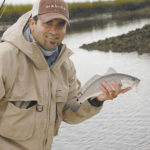
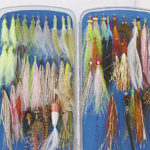
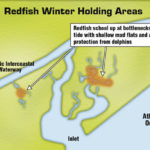
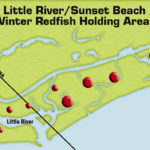



Be the first to comment